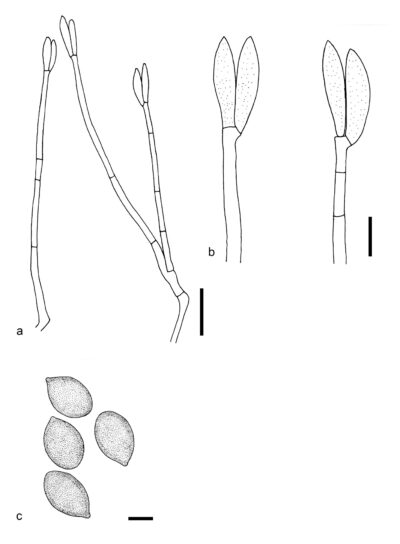Fungalpedia – Note 313, Grandibotrys
Grandibotrys L. Lombard & Crous
Citation when using this entry: Perera et al. 2024 (in prep) – Fungalpedia, genera described in 2016.
Index Fungorum, Facesoffungi, MycoBank, GenBank, Fig. 1
Classification: Stachybotryaceae, Hypocreales, Hypocreomycetidae, Sordariomycetes, Pezizomycotina, Ascomycota, Fungi.
Lombard et al. (2016) established Grandibotrys for two stachybotrys-like taxa with large, olivaceous green to dark brown conidia that have a mammiform apical and/or basal protrudance. Furthermore, they clustered distantly from the Stachybotrys s.st clade in cmdA-ITS-rpb2–tub2 phylogeny (Lombard et al. 2016). Grandibotrys is characterized by macronematous mononematous conidiophores occur solitary or in groups, are erect, septate, unbranched or branched, hyaline with thin and smooth walls. The whorls of 2–4 conidiogenous cells arise from the apex of the conidiophores. They are phialidic, subcylindrical to clavate to fusiform, hyaline and smooth-walled with visible collarettes. The conidia are aseptate, olivaceous green to dark brown, limoniform to ellipsoidal with a mammiform apex and a rounded base. They have thick and smooth walls. The sexual morph remains undetermined (Lombard et al. 2016). Grandibotrys species are saprobes that occur on decaying woods (Lombard et al. 2016; Hyde et al. 2017). This genus includes three species (Lombard et al. 2016; Hyde et al. 2017).
Type species: Grandibotrys pseudotheobromae L. Lombard & Crous
Other accepted species: Species Fungorum, search Grandibotrys
Figure 1 – Grandibotrys pseudotheobromae (CBS 136170, ex-type). a Conidiophores. b Conidiogenous cells. c Conidia. Scale bars: a, b = 20 μm, c = 10 μm. Redrawn from Lombard et al. (2016).
References
Entry by
Rekhani Hansika Perera, Center of Excellence in Fungal Research, Mae Fah Luang University, Chiang Rai, 57100, Thailand.
(Edited by Kevin D. Hyde, Samaneh Chaharmiri-Dokhaharani, & Achala R. Rathnayaka)
Published online 27 August 2024
